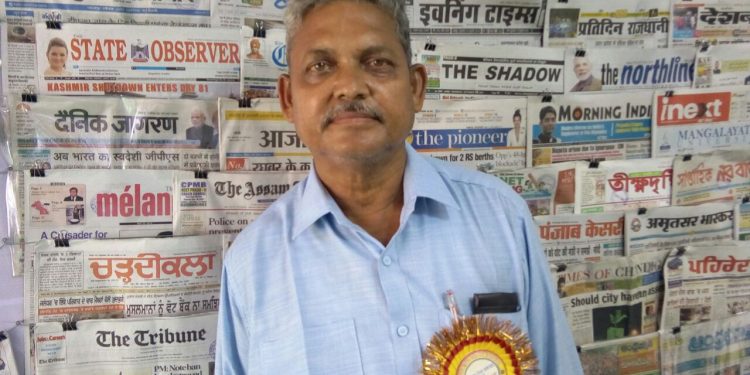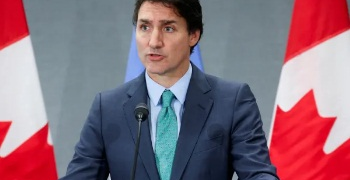Well, newspapers and magazines are considered the chroniclers of history in today’s world. But shouldn’t somebody document the history of these chronicles? This thought was the trigger for Bimal Chandra Sarangi, 64, to set up the Karunamayee Memorial Newspaper Museum at Khurda. At a time when people of his ilk would like to spend time in leisure and peace, Bimal keeps travelling to various nations and destinations to enrich his museum. Bimal has a collection of 2,816 newspapers and periodicals from across the globe. In a candid conversation with Sunday Post, Bimal unravels the difficulties he encountered while building a museum.
Ask him how he developed this monument of reading material, he would respond, “I used to read 10-12 newspapers a day. My favourite pastime used to be browsing through newspapers while sipping a cup of tea. One fine morning, a journalist from a leading daily advised me to launch a museum of newspapers. His advice fuelled the passion in me to take up the challenge. Besides, I was inspired by Dasarathi Pattnaik, popularly known as Dasia Aja, who was considered the father of the library movement in Odisha. He had visualised libraries as reservoirs of priceless resources that facilitate self-education and disseminate knowledge in the society. Dasia Aja was a writer of repute and activist of eminence sans formal education. However, he had developed an addiction for reading at a young age and read whatever came his way. In the late 1950s, when ‘‘education for all’’ was a far cry, Dasia Aja had single-handedly set up a massive library in a non-descript village of Udaypur in Nayagarh district. I remember his heyday when he used to visit our house and collect 10 paisa from every household to build a library for posterity. After my retirement from Cooperative Department in March 2013, I was planning to do something concrete to engage myself in some socially relevant pastime.”
He continues: “It was then I decided to come up with a museum and dedicate it to my late wife Karunamayee Sarangi. Inaugurated in April 2016, the museum had showcased 1,410 newspapers and periodicals in different languages including 73 from Andhra Pradesh, 119 from West Bengal, 107 from Maharashtra, 13 from Delhi, 76 from Jharkhand, 45 from Punjab, 79 from Chhattisgarh, 53 from Gujarat, 42 from Uttar Pradesh and 55 from Karnataka. That apart, we collected newspapers from 48 countries.”
To a question on the need for a museum when Google has every possible information under the Sun, Bimal says, “Museums are structures that store things of artistic, cultural, historical, traditional and objects of scientific interest. They not only enrich our knowledge but make us familiar with our past, civilization, religion, art and architecture. Therefore, museums are also called storehouses of history. Our future generation can learn about us through museums. I was also inspired by newspaper collector Sasanka Sekhar Dash’s book Khabar Kagaja ra Katha.”
Bimal’s effort to collect newspapers from other states for his museum was not an easy task. Reminiscing about his initial days, he recounts, “Once I had been to Guwahati where I managed to collect five newspapers after much persuasion. A police inspector intercepted me suspecting some foul play. When the superintendent of police came to learn about my noble initiative, he praised me and reprimanded the concerned inspector for his behaviour. That’s not all. He instructed an official to drop me at the bus stop.”
“During my trip to Mumbai, I had almost missed the train when I alighted from the compartment to collect some local newspapers from a hawker. A railway inspector warned me against crossing railway track desperately. When he came to know about my passion, he helped me catch my train. During my 10-day stay at Kolkata, I managed to buy 157 papers. I too collected papers from Madhya Pradesh, Indore, Bilaspur and Gwalior. I managed to collect 30 newspapers from Arunachal Pradesh with the help of an Orissa-based journalist hailing from that state. A few fellow pensioners have also extended their support for the cause.”
Apart from Odia, Bimal has original copies of newspapers published in English, Hindi, Bengali, Urdu, Gujarati, Asamese, Khasi, Garo, Nepali, Tamil, Malayalam, Telugu, Marathi, Kashmiri, Chhatishgarhi, Koshali, Punjabi, Sanskrit and Mizo. The museum also houses international publications.
When asked how he got copies of some international publications, Bimal Chandra Sarangi says, “My friend’s daughter who resides in the UK helped me bring newspapers from European countries. Sometimes my friends have got the papers for me. I’ve also sought the help of many newspaper offices. Apart from India, I have newspapers from countries like Nepal, Bhutan, Sri Lanka, UAE, England, US, China, Kenya, Arab, Oman, Nigeria, Bangladesh, Germany, France, Spain and Hong Kong SAR.”
When asked about the method of preservation of periodicals, Bimal Chandra Sarangi said, “I keep all newspapers in separate polythene folders. I am also a keen collector of currency and numismatics. I have preserved coins and currency of 117 countries with me.”
Do you have a message to give it to the society? He says, “By 2100 there would be no printed newspapers in the market. People would no longer watch Lok Sabha channel to know parliamentary proceedings. Nowadays, people have access to YouTube to stream Lok Sabha proceedings. A US readership survey suggests a decline in newspapers in that country. In Orissa 173 newspapers or periodicals are being printed every day. In view of e-editions readers have abandoned reading newspapers. Without exaggeration, it can also be said that the number of voracious readers has gone down. Besides, quality of newspapers has degenerated over the years as the newspaper barons have accorded more importance to advertisement revenue than maintaining the quality of the content. Everyone must read newspapers to stay updated with newspapers. I would like to urge the youngsters to maintain the habit of reading papers. It’s difficult to trigger the passion of reading papers once the habit is lost.”
Bimal Chandra Sarangi who spends most of his pension amount for the “cause of museum” expresses his gratitude to fellow newspaper collectors Sasanka Sekhar Dash of Jajpur, Raj Kishore Sarangi of Berhampur, Sujit Patnaik of Keonjhar, Bhibhuti Patnaik of Jatni, Sanjay Sahu from Nayagarh and Kishore Patnaik of Gania for his noble endeavour.
Rashmi Rekha Das, OP







































